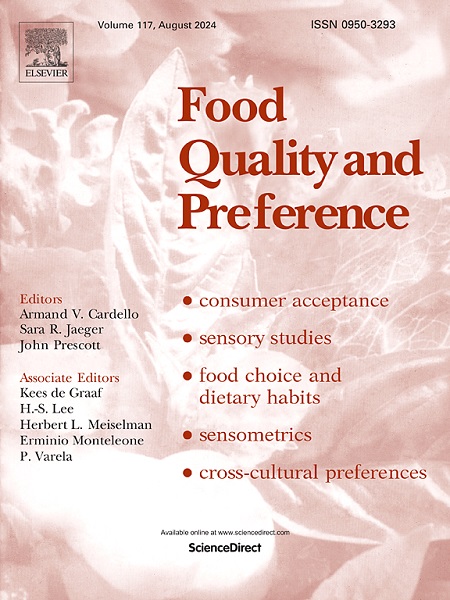How do omnivore consumers perceive plant-based alternatives to yoghurt, cheese, eggs and salmon? Comparison with animal-based counterparts and consideration of the effect of nutrition and ingredient information
IF 4.9
1区 农林科学
Q1 FOOD SCIENCE & TECHNOLOGY
引用次数: 0
Abstract
This research was motivated by the sustainable food transition and focused on plant-based (PB) alternatives to yoghurt, cheese, eggs and fish (salmon). An online study was conducted with 1667 consumers from the United Kingdom who were omnivores. Among participants, 24 % were restricted omnivores (or flexitarians) and made some efforts to reduce their animal food intake. Written names were used as product stimuli and varied according to protein type (PB or animal-based). Compared with animal foods, the findings revealed a strong negative perception of PB variants that spanned the four product categories and seven response variables – overall appeal, healthy, affordable, good for the environment, tasty, natural, and versatile. Further, it extended to behavioural intention, where willingness to eat the PB variants was much lower than for the animal-based counterparts. The effect of nutrition and/or ingredient information on product perceptions and behavioural intent was examined, but no major effect was found. When participants were segmented according to their stated willingness to transition to a vegetarian diet, those with a higher willingness (∼1/3 of the total sample) perceived the PB variants more positively than those with lower transition willingness. This latter group (19 % of participants) also showed a significantly higher willingness to eat the PB food alternatives. Collectively, the findings contribute to the accumulating evidence that PB alternatives to animal foods may face many barriers to uptake among consumers who are currently not open to major dietary changes towards sustainability.
杂食消费者如何看待以植物为基础的酸奶、奶酪、鸡蛋和鲑鱼替代品?与动物性食品的比较,并考虑营养和成分信息的影响
这项研究以可持续食品转型为动机,重点关注酸奶、奶酪、鸡蛋和鱼(三文鱼)的植物基(PB)替代品。我们对英国的 1667 名杂食消费者进行了在线调查。参与者中有 24% 是限制性杂食者(或灵活主义者),他们在一定程度上努力减少动物性食物的摄入量。书面名称被用作产品刺激,并根据蛋白质类型(PB 或动物性蛋白质)而有所不同。与动物性食品相比,研究结果显示,人们对 PB 变体有强烈的负面看法,这种看法涉及四个产品类别和七个反应变量--整体吸引力、健康、经济实惠、有益于环境、美味、天然和多功能。此外,它还延伸到了行为意向上,即食用 PB 变体的意愿远远低于食用动物性食品的意愿。我们还研究了营养和/或成分信息对产品认知和行为意向的影响,但没有发现重大影响。根据参与者过渡到素食的意愿对其进行细分后,意愿较高者(占样本总数的 1/3)比过渡意愿较低者对果胶砖变体的看法更积极。后一类人(占参与者的 19%)食用 PB 食物替代品的意愿也明显较高。总之,这些研究结果为不断积累的证据做出了贡献,即动物性食品的果肉粉替代品可能会面临许多障碍,难以被那些目前尚不愿意为实现可持续发展而做出重大饮食改变的消费者所接受。
本文章由计算机程序翻译,如有差异,请以英文原文为准。
求助全文
约1分钟内获得全文
求助全文
来源期刊

Food Quality and Preference
工程技术-食品科技
CiteScore
10.40
自引率
15.10%
发文量
263
审稿时长
38 days
期刊介绍:
Food Quality and Preference is a journal devoted to sensory, consumer and behavioural research in food and non-food products. It publishes original research, critical reviews, and short communications in sensory and consumer science, and sensometrics. In addition, the journal publishes special invited issues on important timely topics and from relevant conferences. These are aimed at bridging the gap between research and application, bringing together authors and readers in consumer and market research, sensory science, sensometrics and sensory evaluation, nutrition and food choice, as well as food research, product development and sensory quality assurance. Submissions to Food Quality and Preference are limited to papers that include some form of human measurement; papers that are limited to physical/chemical measures or the routine application of sensory, consumer or econometric analysis will not be considered unless they specifically make a novel scientific contribution in line with the journal''s coverage as outlined below.
 求助内容:
求助内容: 应助结果提醒方式:
应助结果提醒方式:


